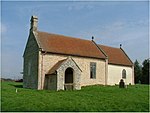Stanford, Norfolk

Stanford is a deserted village and civil parish in the English county of Norfolk. It is situated 7+1⁄2 miles (12 km) north of the town of Thetford and 25 miles (40 km) southwest of the city of Norwich.The name of the village derives from Old English and means "stony ford".The village became deserted when it was taken over by the British Army during the Second World War as part of the Stanford Battle Area, an infantry training area that is still in use. The village and most of the parish are within a restricted area and access is not allowed without special permission from the Army.The parish church of All Saints, like the other surviving churches within the training area, is fitted with blast-proof sheeting to protect the structure, and wire fencing surrounds the church and churchyard to protect from military manoeuvres.The civil parish has an area of 5.26 sq mi (13.6 km2) and in the 2001 census had a population of eight in four households. For the purposes of local government, the parish falls within the district of Breckland. At the 2011 census the population remained less than 100 and was included in the civil parish of Croxton.
Excerpt from the Wikipedia article Stanford, Norfolk (License: CC BY-SA 3.0, Authors, Images).Stanford, Norfolk
Breckland District Stanford
Geographical coordinates (GPS) Address External links Nearby Places Show on map
Geographical coordinates (GPS)
| Latitude | Longitude |
|---|---|
| N 52.51848 ° | E 0.7299 ° |
Address
Stanford
IP26 5JQ Breckland District, Stanford
England, United Kingdom
Open on Google Maps











